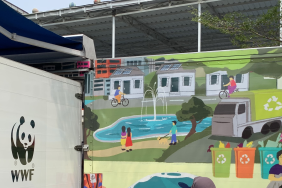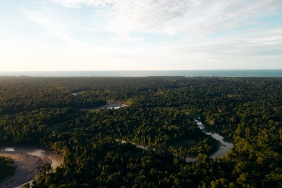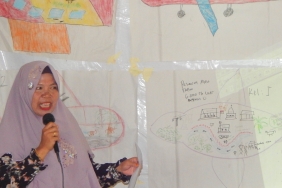DISCUSSION IN BUMI PANDA ABOUT THE FATE OF THE JAVAN RHINO
By: Rosie Ferawati (volunteer Bumi Panda)
Of the five remaining rhino species in the world, two are in Indonesia, the Javan rhino and the Sumatran rhino. Although these species appear strong because they have mosaic skin that resembles armor, they are critically endangered and under constant threat of extinction. Therefore, on Saturday (13/08/2018), WWF-Indonesia held a discussion on Javan rhino with Yuyun Kurniawan, WWF-Indonesia's Ujung Kulon Project Leader. The discussion titled "What's wrong with the Javan Rhino?" was held at Bumi Panda, Jl. Geusan Ulun No. 3 Dago, Bandung.
The activity began with the opening by the MC and the screening of a documentary video entitled "Ekspedisi Cula Baja" which tells the story of a student who made an expedition to Ujung Kulon with the aim of seeing the current existence of Javan rhinos. After the screening, Yuyun Kurniawan or familiarly called Kang Yuyun presented material about Javan rhinos. The discussion began with the presentation of three main problems that greatly affect the Javan rhino population. The three problems are the dynamics of the Javan rhino population, threats to Javan rhino conservation efforts, and issues or discourses regarding the second habitat.
The difficulty of rhinos reproducing is one of the obstacles in the growth of the Javan rhino population. The rhino's long gestation period means it can only reproduce two or three times in its lifetime. On the other hand, the shy nature of female rhinos makes the intensity of meeting male and female rhinos very minimal. In addition, female rhinos are usually reluctant to be approached by male rhinos as long as their cubs have not been released by the female rhino.
In addition to population problems, there are other threats to Javan rhino conservation efforts, including disaster-prone locations, decreased habitat carrying capacity by invasive species, competition for space and food with banteng, disease threats, potential poaching, and small and single populations (inbreeding).
One of the programs scheduled by the government to save the Javan rhino is to create a second habitat, which has also been outlined in the Permenhut No. 43 of 2007. The purpose of the second habitat is to increase the population by 20% and establish a Javan rhino sanctuary. The purpose of this second habitat is to move some Javan rhinos from their first habitat to be developed in the second habitat. The area of lowland forest that is quite similar to the situation in Ujung Kulon that is planned to be the second habitat development for Javan rhinos is in the Sukabumi area. It is hoped that it will not only stop at the second habitat development, but can be continued to the third, fourth, and so on to avoid the extinction of Javan rhinos, especially as a result of disease outbreaks and natural disasters.
The remaining rhinos are currently approximately 65 individuals based on 2015 data. To determine the number of Javan rhinos, the WWF team initially only measured rhino footprints using two methods, namely the Schenkel method or the Nico method. However, this method of measuring rhino footprints is actually less effective because rhinos generally have the same footprint size, so at that time they were only classified based on age. Currently, this method is no longer used. The current tool used to help determine the number of rhinos is the use of camera traps that can capture moving images, including rhinos.
The discussion was lively. The participants, who were mostly students in the Bandung area, were very interested in the information presented about the Javan rhino. Before the discussion ended, one of the participants asked, "From Mr. Yuyun's presentation, I understand that the biggest threat to the Javan rhino is disaster-prone locations and disease outbreaks, sir? Not poaching?" The question was confirmed by Kang Yuyun. Currently, poaching is rare, but what should be watched out for is disease outbreaks and the location of the Ujung Kulon conservation area which is close to the position of the active Anak Krakatau volcano. In the event of a catastrophic eruption of the volcano, the Ujung Kulon area could be devastated by a tsunami.
"Javan rhinos need to get more attention because the choice is only to survive or become extinct. Public and government awareness of the existence of Javan rhinos in Ujung Kulon is very much expected because sustainability is born from the heart," concluded Yuyun Kurniawan closing the discussion





